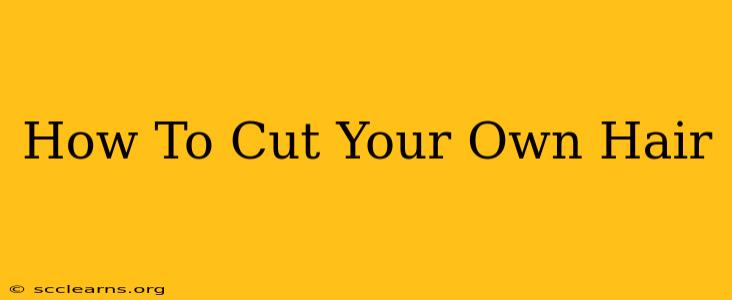Cutting your own hair can seem daunting, but with the right tools and techniques, you can achieve surprisingly great results, saving money and gaining a new skill. This comprehensive guide will walk you through the process, offering tips for different hair types and styles. Whether you're aiming for a simple trim or a more dramatic change, we've got you covered.
Preparing for the Big Chop: Essential Tools and Tips
Before you grab those scissors, gather your supplies. You'll need:
- Sharp Hair Cutting Scissors: This is crucial! Dull scissors will create split ends and an uneven cut. Invest in a good pair specifically designed for hair.
- Hair Clips: To section your hair neatly.
- Wide-Tooth Comb: To detangle your hair and create even sections.
- Spray Bottle: Filled with water to keep your hair damp and manageable.
- Mirror: Preferably two – one to see the back of your head and one for the front.
- Optional: Hair Cutting Shears: For thinning out thicker hair.
Pro Tip: Work in a well-lit area with ample space. Don't rush the process. Patience is key to a successful haircut.
Understanding Your Hair Type
Knowing your hair type is vital. Different hair textures require different approaches:
- Fine Hair: Requires gentler handling to avoid thinning it out too much. Shorter, layered cuts often work best.
- Thick Hair: Benefits from thinning shears to reduce bulk. Blunt cuts can look stunning.
- Curly Hair: Needs to be cut when dry to avoid shrinkage surprises. Use less water to maintain the curl’s definition.
- Straight Hair: Easier to cut straight across, allowing for more precise cuts.
Step-by-Step Guide to Cutting Your Own Hair
These instructions are for a basic trim. For more complex styles, consider watching tutorials specific to your desired look.
- Wash and Condition: Start with clean, damp hair. This makes it easier to manage and cut.
- Detangle: Thoroughly detangle your hair using your wide-tooth comb.
- Section Your Hair: Divide your hair into sections using hair clips. This ensures an even cut.
- Start with the Ends: Begin trimming the ends, working in small sections. Hold the hair taut and cut small amounts at a time.
- Trim Layers (Optional): For layered styles, gently lift sections of hair and trim the ends at an angle.
- Check Your Work: Use your mirrors to check for unevenness and adjust as needed.
- Thinning (Optional): If you have thick hair, use thinning shears to reduce bulk and create a softer look.
- Final Check: Once you're happy with your cut, give your hair a final brush and check for any stray hairs.
Cutting Specific Styles: Bangs, Layers, and More
Cutting bangs or creating layers requires extra precision. Always start by cutting small amounts, and refer to detailed video tutorials before attempting these more advanced techniques. Search for “how to cut bangs yourself” or “how to cut layers yourself” on YouTube for visual guidance. Many tutorials cater to different hair types and lengths.
Mastering the Art of DIY Hair Cutting
Practice makes perfect! Don't be discouraged if your first attempt isn't flawless. With each attempt, you’ll gain confidence and improve your skills.
Tips for Success:
- Start small: It's easier to cut more hair off than to put it back.
- Take breaks: Give yourself time to step back and assess your work.
- Watch tutorials: YouTube is a treasure trove of hair-cutting tutorials for all skill levels.
- Don't be afraid to ask for help: If you're struggling, consider asking a friend or family member to help.
Cutting your own hair can be a rewarding experience, saving you money and giving you more control over your style. By following these tips and taking your time, you can achieve a stylish and manageable haircut from the comfort of your own home. Remember, practice makes perfect!

